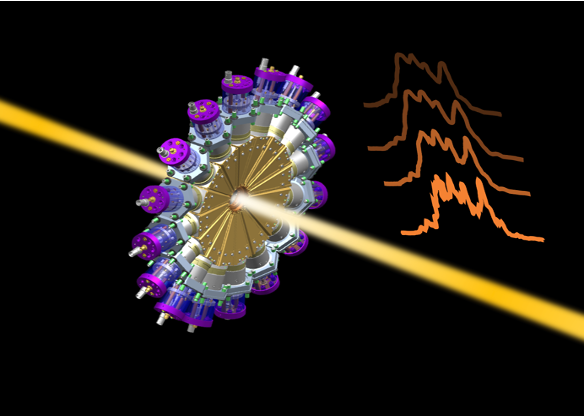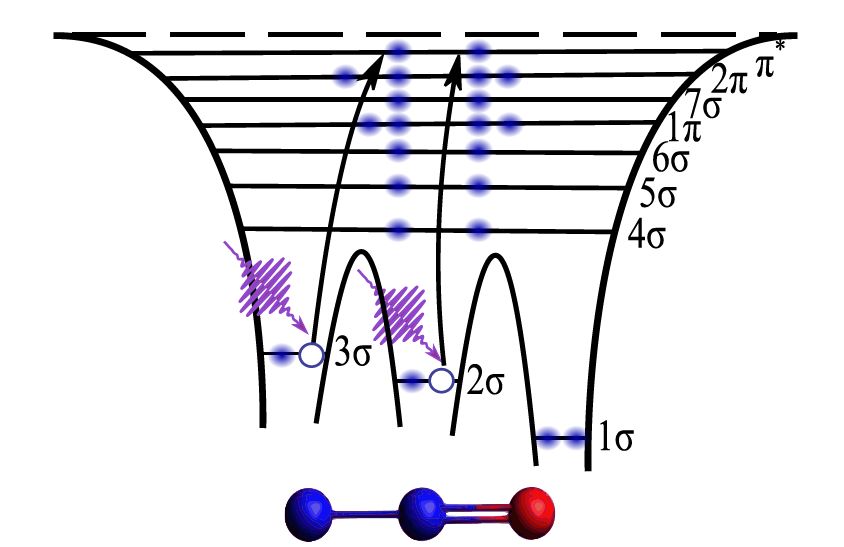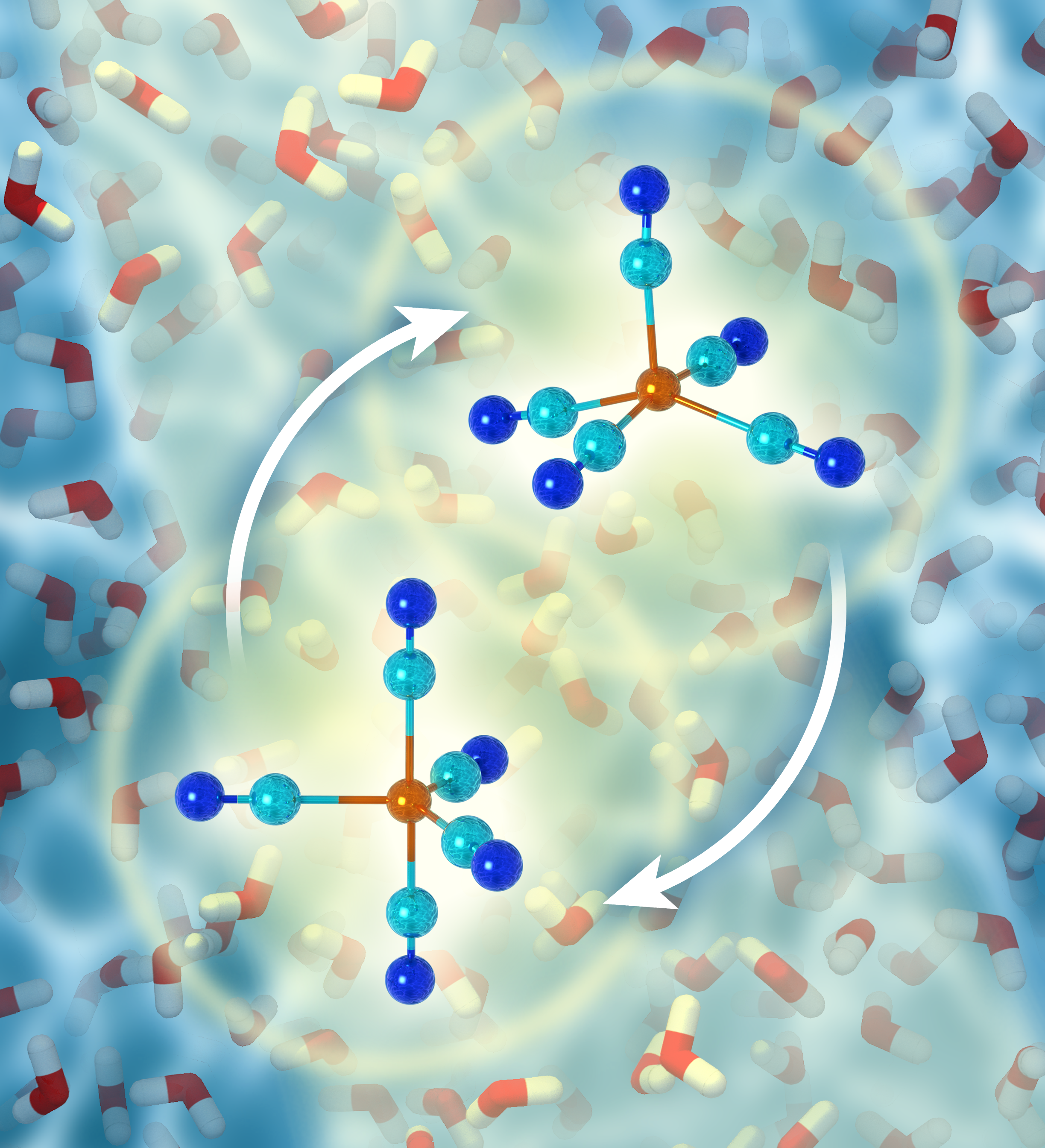X-ray phenomena at the high intensity frontier
Understanding ultraintense X-ray interactions with matter is a new frontier with the advent of X-ray free electron lasers (XFELs), which provide femtosecond X-ray pulses of peak brightness a billion-fold greater than those available from synchrotrons. We examine both single-particle response and propagation through dense media. We explore this frontier with a concerted experimental and theoretical approach, investigating new nonlinear X-ray phenomena and imaging modalities. We use forefront tools, namely worldwide X-ray free electron lasers and high performance computers.
Ultrafast X-ray induced phenomena
Understanding X-ray initiated processes in isolated molecules is a grand challenge problem with broad implications for radiation chemistry, physics and biology. High-brightness tunable ultrafast X-ray pulses, as are available with high-repetition-rate X-ray free electron lasers, will be able to track both inner- and outer-shell electronic motion on their natural timescales with chemical site specificity. These time-resolved studies are complemented by precision, coincidence spectroscopies at synchrotrons, like the Advanced Photon Source at Argonne. The combination of pump-probe and coincident x-ray experiments allows us to isolate motion prior to inner-shell decay and determine the mechanisms that lead to the final outcomes.
X-ray probes of condensed phase photoinduced processes
We focus on understanding the fundamentals of laser-induced phenomena in solution, from the first steps following photoabsorption, with changes in the electronic configuration occurring on the femtosecond time scale, to subsequent processes involved in the evolution of the excited states on the picosecond to microsecond timescales. X-ray spectroscopic probes are used both at synchrotrons and XFELs to track these electronic and structural changes. The upcoming upgraded Advanced Photon Source provides opportunities for high-precision, time-resolved x-ray absorption, emission and Raman spectroscopies at high repetition rate. We have also developed complementary ultrafast optical, infrared transient absorption techniques for these studies. We are especially interested in understanding the influence of the solvent on the reactivity and on influencing the outcome of photoreactions using shaped laser pulses and X-ray feedback.
Recent Publications
- Adam E A Fouda, Dimitris Koulentianos, Linda Young, Gilles Doumy and Phay J. Ho, “Resonant Double-Core Excitations with Ultrafast, Intense Pulses,” Mol. Phys., accepted (2022). https://doi.org/10.48550/arXiv.2208.05307
- Kai Li, Joakim Laksman, Tommaso Mazza, Gilles Doumy, Dimitris Koulentianos, Alessandra Picchiotti, Svitozar Serkez, Nina Rohringer, Markus Ilchen, Michael Meyer and Linda Young. “Ghost-imaging-enhanced noninvasive spectral characterization of stochastic x-ray free-electron-laser pulses.” Communications Physics 5, 1 (2022). https://doi.org/10.1038/s42005-022-00962-8
- Chelsea Liekhus-Schmaltz, Zachary W Fox, Amity Andersen, Kasper S Kjaer, Roberto Alonso-Mori, Elisa Biasin, Julia Carlstad, Matthieu Chollet, James D Gaynor, James M Glownia, Kiryong Hong, Thomas Kroll, Jae Hyuk Lee, Benjamin I Poulter, Marco Reinhard, Dimosthenis Sokaras, Yu Zhang, Gilles Doumy, Anne Marie March, Stephen H Southworth, Shaul Mukamel, Amy A Cordones, Robert W Schoenlein, Niranjan Govind, Munira Khalil, “Femtosecond X-ray Spectroscopy Directly Quantifies Transient Excited-State Mixed Valency,” J. Phys. Chem. Lett. 13, 378-386 (2022). https://doi.org/10.1021/acs.jpclett.1c03613
- L. Gavilan, Phay J. Ho, U. Gorti, H. Ogasawara, C. Jager, F. Salama, “A laboratory-driven multiscale investigation of X-ray induced mass loss and photochemical evolution in cosmic carbon and silicate dust,”Astrophys. J. 925, 86 (2022). https://doi.org/10.3847/1538-4357/ac3dfd
- S. Li, D. Koulentianos, S. H. Southworth, G. Doumy, L. Young, D. A. Walko, R. Püttner, J. D. Bozek, D. Céolin, A. Verma, R. Guillemin, M. N. Piancastelli, M. Simon, L. G. Gerchikov, and S. A. Sheinerman, “Manifestation of post-collision interaction in Krypton LMN Auger spectra following K-shell photoionization,” Phys. Rev. A 106, 023110 (2022). https://doi.org/10.1103/PhysRevA.106.023110
- S. H. Southworth and S. T. Manson, “Perspectives on UV and x-ray photoelectron spectroscopy,” J. Vac. Sci. Tech. A 40, 043002 (2022). https://doi.org/10.1116/6.0001856
- X. Zheng, C. Zhang, Z. Jin, S. H. Southworth, and L. Cheng, “Benchmark relativistic delta-coupled-cluster calculations of K-edge core-ionization energies for third-row elements,” Phys. Chem. Chem. Phys. 24, 13587 (2022).https://doi.org/10.1039/D2CP00993E
- Phay J. Ho, Gilles Doumy and Linda Young, “X-ray Free-electron Lasers: a New Tool for Atomic, Molecular and Chemical Dynamics” Chapter 2 in Emerging Trends in Chemical Applications of Lasers, 15-48 (2021).https://10.1021/bk-2021-1398.ch002
- Akinobu Niozu, Yoshiaki Kumagai, Hironobu Fukuzawa, Naomichi Yokono, Daehyun You, Shu Saito, Yu Luo, Edwin Kukk, Claudio Cirelli, Jonas Rist, Isabel Vela-Perez, Takashi Kameshima, Yasumasa Joti, Koji Motomura, Tadashi Togashi, Shigeki Owada, Tetsuo Katayama, Kensuke Tono, Makina Yabashi, Linda Young, Kazuhiro Matsuda, Christoph Bostedt, Kiyoshi Ueda, and Kiyonobu Nagaya, “Relation between Inner Structural Dynamics and Ion Dynamics of Laser-Heated Nanoparticles,” Phys. Rev. X 11, 031046 (2021). https://doi.org/10.1103/PhysRevX.11.031046
- X. Li, L. Inhester, S.J. Robatjazi, B. Erk, R. Boll, K. Hanasaki, K. Toyota, Y. Hao, C. Bomme, B. Rudek, L. Foucar, S.H. Southworth, C.S. Lehmann, B. Kraessig, T. Marchenko, M. Simon, K. Ueda, K.R. Ferguson, M. Bucher, T. Gorkhover, S. Carron, R. Alonso-Mori, J.E. Koglin, J. Correa, G.J. Williams, S. Boutet, L. Young, C. Bostedt, S.-K. Son, R. Santra, D. Rolles, and A. Rudenko, “Pulse energy and pulse duration effects in the ionization and fragmentation of iodomethane by ultra-intense hard x-rays,” Phys. Rev. Lett. 127, 093202 (2021).https://doi.org/10.1103/PhysRevLett.127.093202
- Phay J Ho, Christopher Knight, Linda Young, “Fluorescence intensity correlation imaging with high spatial resolution and elemental contrast using intense x-ray pulses,” Structural Dynamics 8, 044101 (2021).https://doi.org/10.1063/4.0000105
- Chelsea E Liekhus-Schmaltz, Phay J Ho, Robert B Weakly, Andrew Aquila, Robert W Schoenlein, Munira Khalil, Niranjan Govind, “Ultrafast x-ray pump x-ray probe transient absorption spectroscopy: A computational study and proposed experiment probing core-valence electronic correlations in solvated complexes,” J. Chem. Phys. 154, 214107 (2021). https://doi.org/10.1063/5.0047381
- T. Barillot, O. Alexander, B. Cooper, T. Driver, D. Garratt, S. Li, A. Al Haddad, A. Sanchez-Gonzalez, M. Agaker, C. Arrell, V. Averbukh, M. Bearpark, N. Berrah, C. Bostedt, J. Bozek, C. Brahms, P.H. Bucksbaum, G. Doumy, R. Feifel, L.J. Frasinski, S. Jarosch, A.S. Johnson, L. Kjellsson, P. Kolorenc, Y. Kumagai, E.W. Larsen, P. Matia-Hernando, M. Robb, J.-E. Rubensson, C. Sathe, R.J. Squibb, J.W.G. Tisch, K. Ueda, M. Vacher, D.J. Walke, T.J.A. Wolf, D. Wood, V. Zhaunerchyk, P. Walter, T. Osipov, A. Marinelli, T. Maxwell, R. Coffee, A. A. Lutman, J. P. Cryan, and J.P. Marangos, “Correlation-driven transient hole dynamics resolved in space and time in the isopropanol molecule”, Phys. Rev. X 11,031048 (2021). https://10.1103/PhysRevX.11.031048
- Adam E. A. Fouda, Phay J. Ho, “Site-specific generation of excited state wavepackets with high-intensity attosecond x rays,” J. Chem. Phys. 154 (22), 224111 (2021). https://doi.org/10.1063/5.0050891
- Haynes, D.C., Wurzer, M., Schletter, A. et al. “Clocking Auger electrons,” Nat. Phys. 17, 512 (2021).https://doi.org/10.1038/s41567-020-01111-0
- D. Koulentianos, S. Carniato, R. Puttner, J.B. Martins, O. Travnikova, T. Marchenko, L. Journel, R. Guillemin, I. Ismail, D. Ceolin, M.N. Piancastelli, R. Feifel, and M. Simon. “The O K(-2)V spectrum of CO: the influence of the second core-hole.” Phys. Chem. Chem. Phys. 23,10780 (2021). https://10.1039/D1CP00607J
- Thomas Rossi, Conner Dykstra, Tyler Haddock, Rachel Wallick, John Burke, Cecilia Gentle, Gilles Doumy, Anne Marie March and Renske van der Veen, “Charge Carrier Screening in Photoexcited Epitaxial Semiconductor Nanorods Revealed by Transient X-ray Absorption Linear Dichroism.”, Nano Lett. 12, 9534 (2021). https://doi.org/10.1021/acs.nanolett.1c02865
- Eli D. Kinigstein, Guy Jennings, Charles A. Kurtz, Anne Marie March, Xiaobing Zuo, Lin X. Chen, Klaus Attenkofer, Xiaoyi Zhang, “X-ray Multi Probe Data Acquisition: A Novel Technique For Laser Pump X-ray Transient Absorption Spectroscopy.”, Rev. Sci. Instrum. 92, 085109 (2021). https://10.1063/5.0050713
- Oliviero Cannelli, Nicola Colonna, Michele Puppin, Thomas C. Rossi, Dominik Kinschel, Ludmila M. D. Leroy, Janina Löffler, James M. Budarz, Anne Marie March, Gilles Doumy, Andre Al Haddad, Ming-Feng Tu, Yoshiaki Kumagai, Donald Walko, Grigory Smolentsev, Franziska Krieg, Simon C. Boehme, Maksym V. Kovalenko, Majed Chergui*, and Giulia F. Mancini, “Quantifying Photoinduced Polaronic Distortions in Inorganic Lead Halide Perovskite Nanocrystals,” J. Am. Chem. Soc. 143, 9048–9059 (2021). https://doi.org/10.1021/jacs.1c02403
- Elisa Biasin, Zachary W Fox, Amity Andersen, Kathryn Ledbetter, Kasper S Kjær, Roberto Alonso-Mori, Julia M Carlstad, Matthieu Chollet, James D Gaynor, James M Glownia, Kiryong Hong, Thomas Kroll, Jae Hyuk Lee, Chelsea Liekhus-Schmaltz, Marco Reinhard, Dimosthenis Sokaras, Yu Zhang, Gilles Doumy, Anne Marie March, Stephen H Southworth, Shaul Mukamel, Kelly J Gaffney, Robert W Schoenlein, Niranjan Govind, Amy A Cordones, Munira Khalil, “Direct observation of coherent femtosecond solvent reorganization coupled to intramolecular electron transfer,” Nature Chemistry13, 343 (2021). https://doi.org/10.1038/s41557-020-00629-3
- Alexander Britz, Sergey I. Bokarev, Tadesse A. Assefa, Éva G. Bajnóczi, Zoltán Németh, György Vankó, Nils Rockstroh, Henrik Junge, Matthias Beller, Gilles Doumy, Anne Marie March, Stephen H. Southworth, Stefan Lochbrunner, Christian Bressler, and Wojciech Gawelda, “Site selective real‐time observation of bimolecular electron transfer in a photocatalytic system using L‐edge X‐ray absorption spectroscopy,” Chem Phys Chem (2021).https://doi.org/10.1002/cphc.202000845
- Linda Young, Emily T. Nienhuis, Dimitris Koulentianos, Gilles Doumy, Anne Marie March, Stephen H. Southworth, Sue B. Clark, Thomas Orlando, Jay A. LaVerne, Carolyn I. Pearce, “ Photon-in/photon-out x-ray free-electron laser studies of radiolysis,” Appl. Sci. Special Issue: Ultrafast X-ray Spectroscopies 11(2), 701 (2021); https://doi.org/10.3390/app11020701


